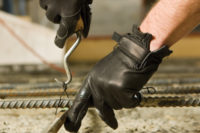Comfort is King
Don’t go on a scavenger hunt for cheap gloves

Cut resistance at any cost?
Here is a typical buying decision scenario. A worker sustains an injury to the hand. It is reported as a cut. The decision is made to buy cut-resistant gloves — with the highest cut rating available. It’s a scene played out too often and at too many facilities. What begins as an effort to demonstrate due diligence for inspectors and supervisors results in the purchase of a glove that is not suited to the application.
In their single-minded focus on cut ratings, many buyers fail to consider that the standardized test against which a high-rated glove has been evaluated might have nothing to do with the threats of their real-world application. They disregard the significant impact of the wrong glove on comfort and productivity. A mismatched glove and application can even result in repetitive strain injuries, swapping one type of injury for another.
Manufacturers, noting buyers’ preference for higher ratings, are motivated to achieve such ratings at any cost, and are inclined to market and sell based on little else. Manufacturers and glove customers must work together to conduct honest and detailed analyses of identified risks, worker comfort and the product’s ability to address each. Again, this entails more than matching numbers on a scale of 1 to 5.
Determining dexterity
That said, most gloves have no dexterity rating. Those that do often undergo a test that requires a subject wearing the glove to pick up five pins of equal length and diameters from 11 mm to 5 mm, the smallest being slightly thinner than an average pencil. This pin test has been adopted by the National Institute of Justice (NIJ), American National Standards Institute (ANSI), and European Certification EN420. While gloves that allow the smallest pin to be picked up will achieve the highest rating, some gloves have a surface with just enough tack to pick up the smaller pins, even though the gloves offer very little true dexterity. Furthermore, a glove on a human hand must have at least 15 points of flexure, and the pin test measures just two — thumb and forefinger.
There is a more comprehensive test, which will provide information about both the fingertip precision of a glove and a glove’s overall impact on hand movement. The Minnesota Manual Dexterity Test involves the rapid placement of 60 individual discs in a series of prescribed test patterns. The Minnesota test is commonly used to assess hand-eye coordination, injury rehabilitation or task aptitude.
The test battery includes assessment of the wearer’s dominant and non-dominant hands, as well as tests requiring both hands to work together to complete prescribed placements of 29 mm discs. After establishing a baseline bare-hand result, a tester then performs the prescribed movements again while wearing gloves. To account for increased proficiency as the tester learns the rhythm of the test movements, a second round of bare-hand results is averaged with the first. Results can also be averaged among testers with various hand sizes.
This process illustrates an overall change in dexterity from bare hand to gloved hand, reported as a percentage. A glove that preserves 85 percent of bare-hand dexterity is said to offer better comfort than a glove that preserves only 75 percent. When subjected to the Minnesota Dexterity test, a glove that easily achieves the highest EN420 dexterity rating might be shown to reduce bare-hand dexterity by as much as 50 percent or more. In this context, it is understandable that a worker might be tempted to remove his or her gloves to perform a task, since it could take 50 percent longer to complete with the gloves on.
A glove that significantly reduces bare-hand dexterity doesn’t just affect productivity. It can also result in injury. The repetitive nature of the Minnesota test can capture the effects of glove pressures throughout the entire hand. In the case of coated gloves, which often enable a wearer to easily pick up small pins, many are manufactured with a pre-curved design. At first blush, the wearer might describe such a glove as a “second skin,” thanks to the glove’s conformity to the shape of the hand. However, as a wearer flexes his or her hand, the glove exerts pressure as it attempts to return to its neutral, pre-curved shape. The cumulative effect of this pressure can cause repetitive strain injuries, even as a wearer reports good general comfort in the glove.
Exercise due diligence
It can seem daunting to apply so much scrutiny to glove selection, and few safety managers have empty room on their plates. But gloves, as with all classes of PPE, are not something to be simply ordered in bulk and checked off a to-do list. Careful evaluation of each of a glove’s properties is essential, and a manufacturer should offer as much open and honest support as possible during that process. Because safety inspectors are becoming ever more aware of these nuances, selection of a glove based on cut rating alone will soon no longer count as “due diligence.”
Looking for a reprint of this article?
From high-res PDFs to custom plaques, order your copy today!





